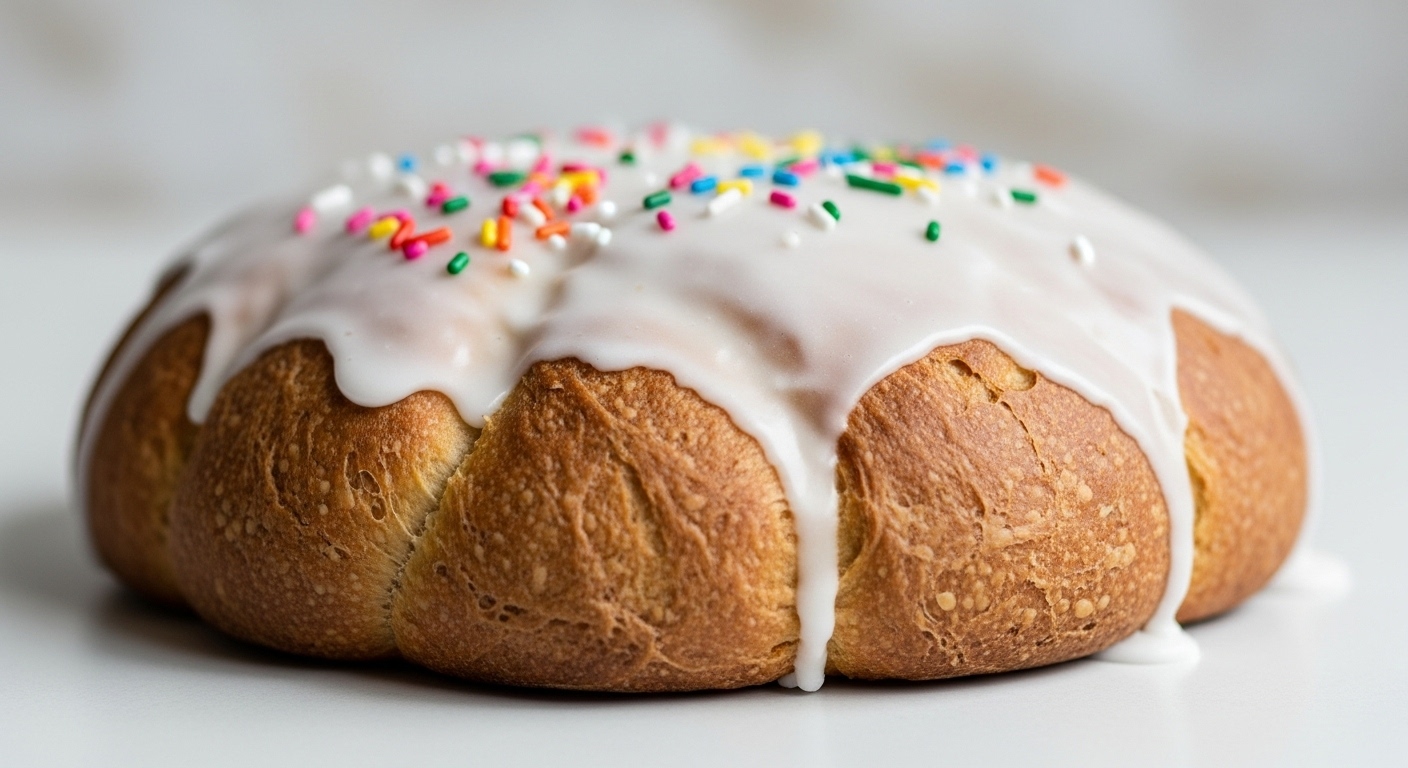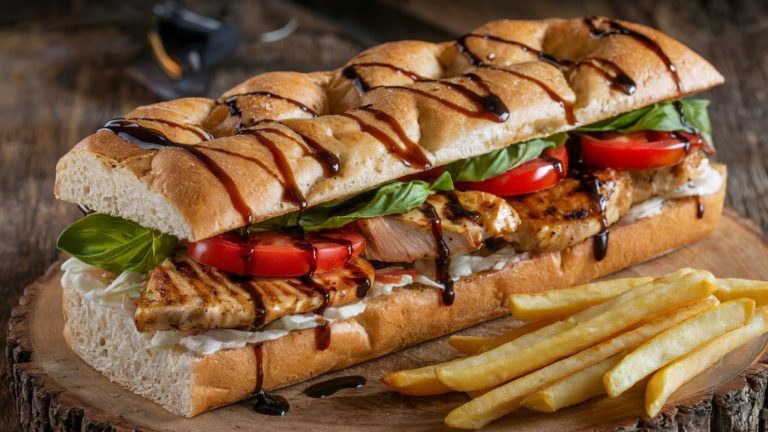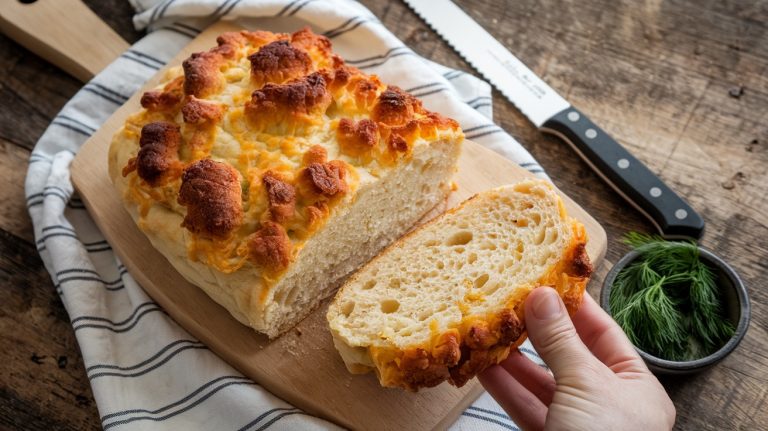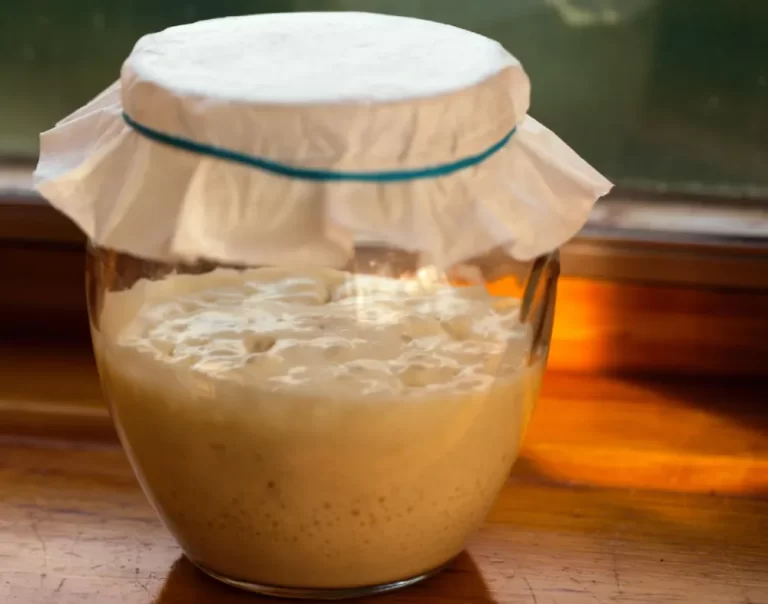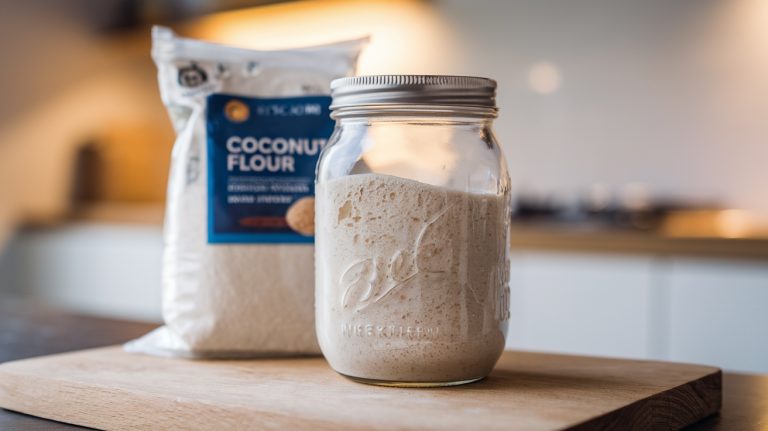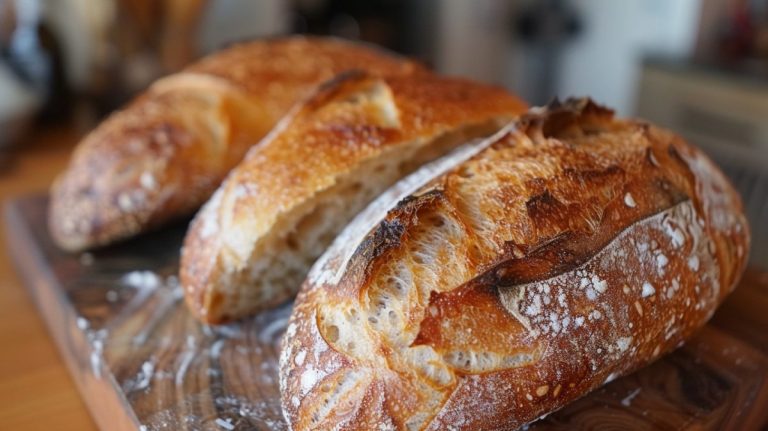Sourdough King Cake: Crowning Glory
Plunge into crafting a sourdough king cake, a Mardi Gras gem with ancient roots! You’ll blend a tangy, active starter with rich ingredients like butter, milk, and cinnamon for unmatched flavor.
Knead a tacky dough, ferment it for depth, shape a traditional ring, and bake until golden. Top it with vibrant purple, green, and gold icing. It’s a passionate baking journey—stick around to uncover the full magic behind this cultural treasure.
Key Takeaways
- Sourdough king cake combines traditional Mardi Gras flavors with natural leavening for a unique, tangy taste.
- Originating from French and Roman traditions, it symbolizes Epiphany and Carnival with hidden figurines for luck.
- Key ingredients include active sourdough starter, bread flour, milk, butter, and festive purple, gold, green toppings.
- Preparation involves mixing, fermenting for 4-12 hours, shaping into a ring, and baking at 350°F for 30-45 minutes.
- Decorate with glossy icing and vibrant sugars, ensuring a warm, humid proofing environment for best results.
Historical Background
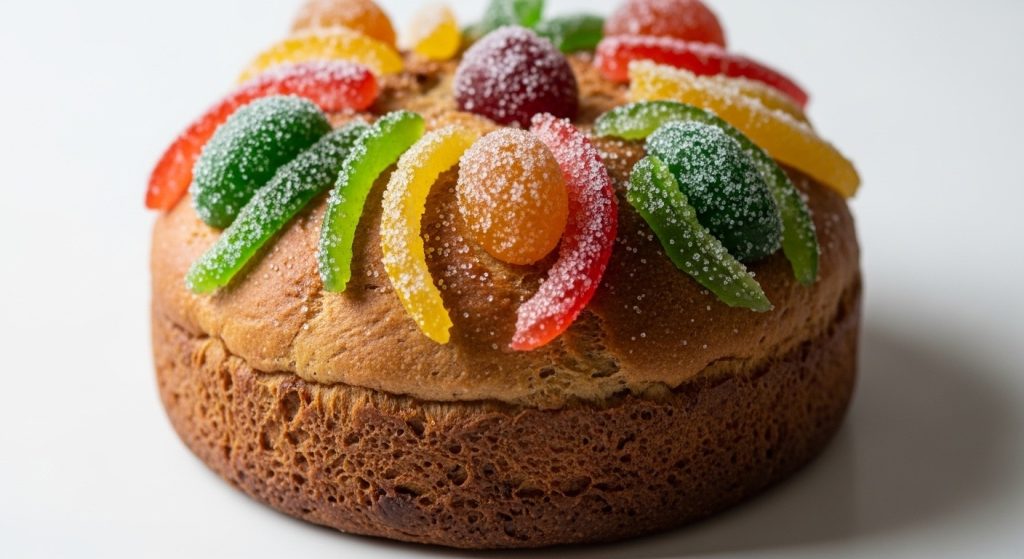
How did a simple cake become a cornerstone of cultural celebration? Explore the rich history of king cake, tracing its roots to 12th-century France and even further to pagan Roman Saturnalia festivals honoring Saturn. You’ll feel the ancient thrill as you imagine early Europeans marking the Three Wise Men’s arrival with this treat, hiding a bean—later a figurine—inside since medieval times.
French settlers carried this vibrant custom to Louisiana in the 18th century, where it evolved with Christian significance for Epiphany, celebrating the Magi’s visit. By the 19th century, Mardi Gras in New Orleans embraced it fiercely, weaving faith, justice, and power into its purple, gold, and green hues.
Introduced to New Orleans in 1870, the cake became a beloved tradition during Carnival Season in 1870. You’re part of this living legacy! Today, bakers can even use convenient mixes like Krusteaz Sourdough Bread Mix to craft their own unique king cake with a tangy sourdough twist.
Essential Ingredients for Sourdough Version
As you plunge into crafting a sourdough king cake, you’ll need a lineup of essential ingredients that bring this festive treat to life with authentic flavor and texture. Start with 125-150 grams of active sourdough starter for natural leavening, paired with 650 grams of bread flour for robust structure.
Embark on your sourdough king cake journey with 125-150 grams of active starter and 650 grams of bread flour for perfect structure.
Add richness using 180 grams of whole milk, 75 grams of unsalted butter, and a large egg. For an even softer texture, consider incorporating a touch of cream cheese into the dough mixture soft texture enhancement. To ensure precision in measuring these ingredients, using a high-quality digital baking scale is essential for consistent results.
Sweeten with 75 grams of granulated sugar, balance with 6-10 grams of salt, and craft a spiced filling with 110 grams of brown sugar and 2-3 grams of cinnamon.
Top it with a glaze of 150 grams powdered sugar and vibrant Mardi Gras sprinkles.
Dive deeper with these flavorful twists:
- Use organic heritage grains for unmatched depth.
- Opt for sea salt to refine taste.
- Add vanilla extract for aromatic allure.
Preparing the Sourdough Levain
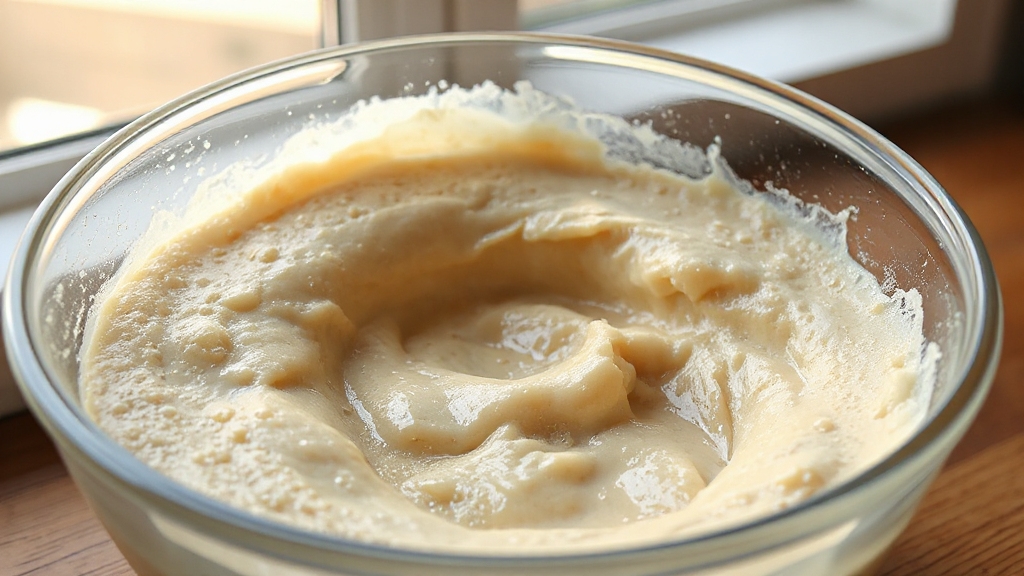
Hey, let’s get that sourdough levain ready for your King Cake with a precise mix of active starter, fresh flour, and water in a 1:1 ratio.
Stir until you’ve got a smooth, thick batter bursting with potential. Set it in a warm spot, around 70-80°F, and watch for it to double in size over 6-12 hours. To ensure readiness, perform the float test by placing a spoonful in water to see if it floats.
Those bubbles signaling the wild yeast is alive and kicking. Don’t rush this fermentation—it’s the heart of your cake’s flavor and rise.
Mixing Levain Ingredients
While beginning your sourdough journey, crafting the perfect levain for your King Cake starts with precision and care. Grab 25–30g of active sourdough starter, and in a clean glass container, dissolve it into filtered water heated to 80°F–100°F. Stir with a fork until it’s smooth. Using a KitchenAid mixer can streamline this process for even consistency.
Then, gradually add an equal weight of flour—bread, rye, or whole wheat—to create a hydrated, batter-like mix. Weighing out the ingredients accurately ensures consistent fermentation results for your levain.
Dive deeper into your levain with these key considerations:
- Flour Choice: Opt for fresh, organic bread flour for robust gluten or rye for complex flavors.
- Water Quality: Use filtered water to dodge chlorine, ensuring vibrant microbial activity.
- Mixing Care: Stir gently but thoroughly to avoid lumps and ensure even hydration.
You’re setting the stage for an unforgettable King Cake with efficient mixing techniques.
Levain Rising Time
After mixing your levain with care, it’s time to let it rise and work its magic for your Sourdough King Cake. Place your stiff levain in a covered liquid measuring cup and set it in a warm, draft-free spot at around 78°F.
Let it rest for 10-12 hours, or overnight, until it doubles—or even triples—in size, with a beautifully rounded top. Watch closely, as temperature and starter activity can tweak the timing; warmer rooms speed things up, while cooler ones slow fermentation.
This rising process is essential, deepening the flavor and building the structure of your king cake. Keep humidity in check to avoid over-proofing, and revel in the anticipation of that perfect rise! Ensuring the levain reaches this stage is crucial for achieving the desired dough consistency. If needed, use a gentle heat source like an oven with the light on to maintain that optimal temperature range.
Mixing and Kneading the Dough
As you begin crafting your sourdough king cake, start by combining your active, bubbly sourdough starter or stiff sweet levain with whole milk, water, sugar, melted butter, eggs, vanilla extract, and a pinch of salt in a large bowl or stand mixer.
Mix with fervor, gradually adding bread flour until you’ve got a shaggy, tacky dough.
Knead it passionately for 8-10 minutes using a dough hook or by hand, aiming for a smooth, elastic texture that’s slightly tacky but not sticky.
Dive deeper into perfecting your dough with these tips:
- Use whole milk for unmatched richness in every bite.
- Balance hydration meticulously—too much flour, and it’s dense; too little, it’s unmanageable.
- Monitor dough temperature to keep sourdough activity ideal.
- Ensure your starter is active and bubbly to guarantee proper fermentation and rise.
- Adjust the dough consistency by adding flour or water in small increments to achieve the perfect elasticity for shaping.
Fermentation Process
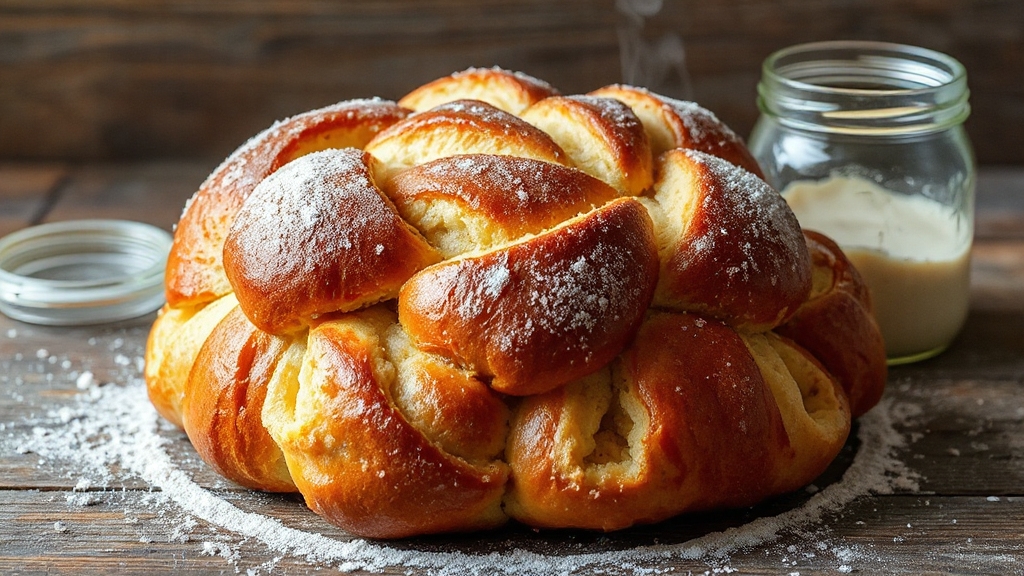
Hey, let’s get into the heart of your sourdough king cake with a vibrant, active starter that’s bubbling with wild yeast and bacteria, fueling the fermentation with intense flavor and lift.
You’ve gotta nail the bulk fermentation timing—aim for 4-6 hours at room temp or a slow 8-12 hours in the fridge to double that dough, letting complex tastes bloom. Remember, this slow process mirrors the traditional cold fermentation used to enhance the dough’s texture and depth of flavor cold fermentation process. During this stage, perform stretches and folds to build dough strength and ensure even gas distribution for a better rise.
Keep your space around 78°F to boost yeast activity, as even a slight chill can sluggish the rise and mess with your cake’s airy magic.
Importance of Active Starter
When you’re diving into the art of baking a sourdough king cake, the heartbeat of your creation lies in an active sourdough starter. It’s packed with wild yeast and bacteria that kickstart fermentation, breaking down sugars into carbon dioxide for a lofty rise and organic acids for that signature tangy depth.
You’ve gotta make certain your starter’s at peak activity—bubbling and doubling in size—because that’s when it guarantees a tender crumb and complex flavor. Remember, a well-fed starter, following the right feeding schedule, ensures consistent fermentation results over time feeding schedule. Regular care of your starter, including consistent nourishment, is essential to maintain its microbial health and baking performance.
Here’s why it’s critical:
- Vitality Check: Look for lively bubbles and a mild tangy aroma to confirm readiness.
- Flavor Impact: Its acids shape the cake’s sour profile, elevating taste.
- Structure Power: It strengthens gluten, ensuring a light, airy texture.
Bulk Fermentation Timing
While you’ve nurtured your active starter to perfection, now it’s time to master the bulk fermentation timing for your sourdough king cake. This pivotal stage, lasting 2 to 6 hours at room temperature, demands your keen attention.
Watch closely as sugar in the dough can speed up fermentation, risking over-proofing if unchecked. Regularly monitor the dough’s progress, ensuring it doubles in size or reaches the desired consistency. For optimal results, maintain a proofing temperature range of 74-76°F to enhance flavor development.
Incorporate stretch and fold techniques to build strength and regulate development. For deeper flavor, consider an overnight fermentation, letting the dough slowly evolve. Remember, this stage is critical for creating organic acids and gases essential for flavor and texture.
Handle it gently to preserve structure, and check often to catch the perfect moment. Master this, and you’re on your way to a regal, flavorful masterpiece!
Temperature Impact on Rise
As you plunge into crafting your sourdough king cake, mastering the temperature impact on the rise is absolutely critical. Temperature dictates fermentation speed and flavor, so keep your dough in the sweet spot of 75°F to 78°F for balanced yeast and bacterial action.
Warmer temps around 80°F boost yeast for a quicker rise, but beware—too hot, and you’ll risk overproofing, wrecking the structure. Cooler temps slow things down, perfect for a controlled, overnight proof in colder months. Consistent dough temperature ensures reliable results across baking sessions, helping you achieve the perfect rise every time. Optimal hydration levels around 65-75% dough hydration also support fermentation and texture during the rise.
Dive deeper into temperature’s role with these key insights:
- Yeast vs. Bacteria: Yeast peaks at 80°F, while bacteria love 89°F, shaping flavor.
- Dough Elasticity: Right temperatures ensure proper gluten for shaping.
- Flavor Balance: Steady warmth crafts that signature tangy crumb.
Crafting the Perfect Filling
Crafting the perfect filling for your sourdough king cake is where you can truly let your creativity shine. Immerse yourself in a classic cinnamon filling with melted butter, brown sugar, and a dash of spice, or whip up a tangy cream cheese blend with vanilla extract for a decadent twist.
Soften your butter and cheese first, then mix until smooth, balancing sweetness with granulated or brown sugar. For a fluffy consistency, beat the mixture with an electric mixer until well combined electric mixer blending. Using a bench scraper can help evenly distribute filling and ensure a consistent layer across the dough.
Experiment with variations like Nutella for a chocolate-hazelnut kick or fruit fillings like raspberry for a burst of freshness. Add flavor enhancers like almond extract or nutmeg to elevate the taste.
Spread your filling evenly with a consistent, spreadable texture, ensuring every bite harmonizes with the sourdough’s unique tang.
Shaping the Traditional Circle
Let’s get that sourdough King Cake into its iconic circular form with flair! Grab your rolled dough log, loop it into a flawless ring, and press those ends together with precision to seal the shape tight, ensuring no filling escapes during baking.
Feel the excitement as you craft this traditional Mardi Gras symbol, knowing every pinch and press locks in the festive magic! Inspired by the oval shape often used in classic king cakes, this circular form pays homage to the traditional style seen in many New Orleans bakeries.
Forming the Circle
Once you’ve crafted your braided rope of sourdough, it’s time to shape it into the iconic circle that defines a traditional king cake. Lay the rope on a parchment-lined baking sheet, gently curving it into a ring. Don’t overstretch the dough; preserve its delicate structure for an even bake. This circle symbolizes the route of the three wise men and the crown’s hollow center, embodying deep cultural meaning.
To perfect your shape, consider these details:
- Ease the braid into a smooth arc, ensuring no sharp bends disrupt the flow.
- Check for uniform thickness along the ring for consistent baking.
- Position the circle centrally on the sheet for balanced heat distribution.
Sealing the Ends
After shaping your sourdough into a beautiful circle, it’s time to focus on sealing the ends to lock in that iconic ring form.
With lightly floured hands, overlap the dough ends slightly, then pinch them firmly to create a tight bond. Fold the edges together for extra strength, ensuring no gaps form during proofing.
Press the seal gently on a floured surface to smooth it, preventing separation or filling leaks. A secure join maintains even rising and that regal crown shape, preserving moisture inside.
Transfer your ring immediately to a parchment-lined baking sheet, handling it gently to avoid breaking the seal. Cover with a damp cloth during proofing, and let the gluten relax before baking.
Baking Tips for Best Results
While crafting a sourdough king cake may seem intimidating, you’ll achieve bakery-worthy results with the right techniques. Preheat your oven to 350ºF (175ºC) and line a baking sheet with parchment paper to prevent sticking.
Bake your shaped cake for 30 to 45 minutes, watching for a golden brown crust and a springy interior as key doneness cues. Don’t rush cooling—let it rest to set the texture. Remember that traditional king cakes often reflect regional preferences in their styles and flavors, adding a unique cultural touch to your baking.
For perfection, consider these tips:
- Monitor baking closely; ovens vary, so trust visual cues over strict timing.
- Brush softened butter on top before baking to enhance browning and flavor.
- Adjust proofing times if using an active starter to prevent overproofing.
Decorating With Royal Icing and Sugars
As you set out on decorating your sourdough king cake, envision transforming it into a vibrant masterpiece with royal icing and colored sugars. Start by whipping up a glossy royal icing with meringue powder and powdered sugar, tweaking consistency with lemon juice for perfect shine. Apply a thin, even base layer of white icing on your cooled cake using a palette knife, smoothing edges with a scraper for a flawless finish.
Next, divide icing into batches, tinting them with gel dyes for bold hues. Pipe precise designs with a fine-tipped bag, layering colors one at a time. Sprinkle vibrant purple, green, and gold sugars over wet icing for sparkle, letting each section set to avoid smudging.
For an extra regal touch, consider using silicone molds to create intricate fondant embellishments silicone molds used that elevate the cake’s majestic appearance.
Cultural Traditions and Symbolism
Beyond the vibrant hues and intricate designs of your sourdough king cake lies a deeper story woven into its very essence. You’re not just baking a treat; you’re crafting a symbol of ancient traditions, from Roman Saturnalia’s role reversals to Epiphany’s divine revelation.
Feel the weight of history as you hide a token inside, echoing medieval French luck and modern Mardi Gras joy. Your cake becomes a vessel for tradition, carrying the hidden figurine or bean that signifies good luck for the finder.
Dive into the layers of meaning with these cultural threads:
- Saturnalia’s inversion: You honor freedom and social questioning.
- Epiphany’s kingship: You celebrate the Magi’s arrival and Christ’s light.
- New Orleans’ community: You strengthen bonds through shared festivity.
Frequently Asked Questions
Can I Freeze Sourdough King Cake?
You’re wondering if you can freeze baked goods to keep them fresh, and I’m thrilled to help! Absolutely, you can freeze them with ease. Make sure they’ve cooled completely, then wrap each piece tightly in aluminum foil to lock in moisture.
Pop them into an airtight container or freezer bag, squeezing out air. They’ll stay delicious for up to two months. Thaw at room temp and reheat gently!
How Long Does It Stay Fresh?
You’ve baked a masterpiece, and now you’re wondering how long it’ll stay fresh. Think of freshness like a fleeting sunset—beautiful but brief. Without proper care, it fades in just 2-3 days at room temperature.
Seal it tight in an airtight container, and you’ll lock in that soft, tender texture. Don’t let it dry out; keep it covered, and if needed, warm it slightly to revive its vibrant charm!
Can I Use Alternative Sweeteners?
You can absolutely use alternative sweeteners to craft something amazing! Delve into options like honey for a floral sweetness or Swerve for a sugar-free kick. You’ll need to tweak hydration and watch fermentation closely since yeast reacts differently. Notice how substitutes might alter texture or browning, so adjust with passion.
Keep an eye on proofing to nail that perfect rise, and let your creativity shine through every bite!
What if My Starter Isn’t Active?
If your starter isn’t active, don’t panic! Check for bubbles, rise, or that tangy aroma—if they’re missing, it’s sluggish.
Feed it twice daily with fresh flour and water, using a 1:2:2 ratio.
Move it to a cozy spot, around 75°F, to wake it up.
Watch closely for growth over 24 hours.
Stay patient; revive it with consistent care, and you’ll see that vibrant life return!
How to Store Leftovers Properly?
Stash your scrumptious surplus safely! You’ve gotta wrap leftovers tightly in plastic wrap to lock in luscious moisture. Pop them into an airtight container to shield from sneaky staleness. Don’t skimp on snug sealing—loose wraps let air attack!
For longer storage, freeze with fierce protection using heavy-duty foil. Keep at room temp for three days max, or freeze un-frosted for two marvelous months. Preserve that perfect bite!
A Slice of Celebration: Sourdough King Cake & the Spirit of Mardi Gras
You’ve crafted a sourdough king cake, a masterpiece of history and flavor. Like a Mardi Gras parade weaving through New Orleans streets, your cake’s golden crust and vibrant sugars dance with tradition.
Did you know over 750,000 king cakes are devoured each Carnival season? Let your creation reign as king, crowned with icing and memories. Slice it, share it, and revel in the joyous rhythm of celebration.

